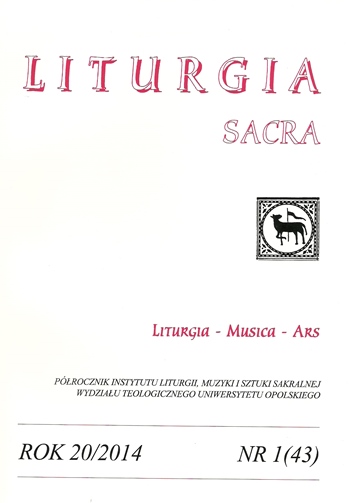Ekumeniczne nieautoryzowane modlitwy eucharystyczne
The unauthorised ecumenical eucharistic prayers
Author(s): Maciej PrzybylakSubject(s): Christian Theology and Religion, Theology and Religion
Published by: Uniwersytet Opolski
Keywords: ecumenical eucharistic prayers; Canon of Taizé; Canon of Christian Unity; Canon of Lima Liturgy; let all be one
Summary/Abstract: After the II Vatican Council, the position of the Roman Canon was disturbed. Some theologians and liturgists began to create new anaphoras without authorisation of the Holy See. The phenomen of the uncontroled liturgical progression coincided with the ecumenical opening of the Catholic Church. Thus ecumenical eucharistic prayers began to be created and distributed. One of the most significant person in this process was Max Thurian, member of Taizé ecumenical community who as first before the II Vatican Council adapted the Roman Canon according to the ecumenical reasons. Three anaphoras was analysed: Canon of Taizé published in 1967, Canon of Christian Unity issued in Baltimore in 1968 and Canon of Lima Liturgy from 1982. They represent three different circles that edited and applied them during the celebrations. Even if Max Thurian is author of two mentionned anaforas, they emerged in different circumstances. Three ecumenical eucharistic prayers presented here, show up three features related with theological divergences concerning the understanding of the Eucharist as well as the existance of the purgatory: the Eucharist is not called sacrifice directly, rather defined as a sign of the Jesus sacrifice, the real presence of Jesus Christ in bread and wine is not expressed enough, the intercessions for the dead who passed away are omitted. On the other side, all ecumenical anaphoras emphasise the prayer for the unity of the Christians according to Saviours will let all be one. The application of these ecumenical eucharistic prayer is not know in all their dimensions. There were used particulary during the Eucharist with the participation of other non-catholic Christian. Even if these anaphoras were never approved by the Holy See, they deserve an attention, because apart from the theological divergences, they manifest the strong desire of Christian unity, where all could celebrate one Eucharist that is the sacrament of unity indeed.
Journal: Liturgia Sacra
- Issue Year: XX/2014
- Issue No: 43
- Page Range: 43-52
- Page Count: 10
- Language: Polish
- Content File-PDF

